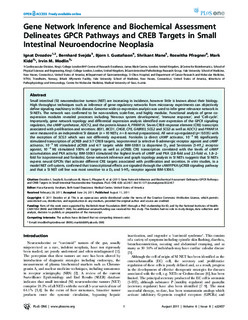Gene Network Inference and Biochemical Assessment Delineates GPCR Pathways and CREB Targets in Small Intestinal Neuroendocrine Neoplasia
Drozdov, Ignat; Svejda, Bernhard; Gustafsson, Björn; Mane, S; Pfragner, Roswitha; Kidd, Mark; Modlin, Irvin M
Journal article, Peer reviewed
Permanent lenke
http://hdl.handle.net/11250/2365776Utgivelsesdato
2011Metadata
Vis full innførselSamlinger
Sammendrag
Small intestinal (SI) neuroendocrine tumors (NET) are increasing in incidence, however little is known about their biology. High throughput techniques such as inference of gene regulatory networks from microarray experiments can objectively define signaling machinery in this disease. Genome-wide co-expression analysis was used to infer gene relevance network in SI-NETs. The network was confirmed to be non-random, scale-free, and highly modular. Functional analysis of gene co-expression modules revealed processes including ‘Nervous system development’, ‘Immune response’, and ‘Cell-cycle’. Importantly, gene network topology and differential expression analysis identified over-expression of the GPCR signaling regulators, the cAMP synthetase, ADCY2, and the protein kinase A, PRKAR1A. Seven CREB response element (CRE) transcripts associated with proliferation and secretion: BEX1, BICD1, CHGB, CPE, GABRB3, SCG2 and SCG3 as well as ADCY2 and PRKAR1A were measured in an independent SI dataset (n = 10 NETs; n = 8 normal preparations). All were up-regulated (p<0.035) with the exception of SCG3 which was not differently expressed. Forskolin (a direct cAMP activator, 10−5 M) significantly stimulated transcription of pCREB and 3/7 CREB targets, isoproterenol (a selective ß-adrenergic receptor agonist and cAMP activator, 10−5 M) stimulated pCREB and 4/7 targets while BIM-53061 (a dopamine D2 and Serotonin [5-HT2] receptor agonist, 10−6 M) stimulated 100% of targets as well as pCREB; CRE transcription correlated with the levels of cAMP accumulation and PKA activity; BIM-53061 stimulated the highest levels of cAMP and PKA (2.8-fold and 2.5-fold vs. 1.8–2-fold for isoproterenol and forskolin). Gene network inference and graph topology analysis in SI NETs suggests that SI NETs express neural GPCRs that activate different CRE targets associated with proliferation and secretion. In vitro studies, in a model NET cell system, confirmed that transcriptional effects are signaled through the cAMP/PKA/pCREB signaling pathway and that a SI NET cell line was most sensitive to a D2 and 5-HT2 receptor agonist BIM-53061.
